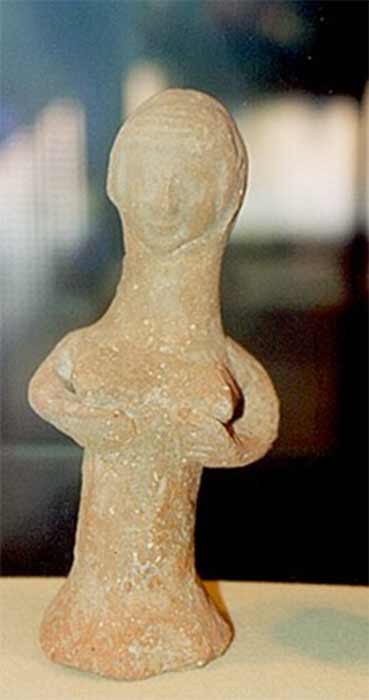
Tracing The Footprints Of The Philistines To Minoan Knossos On Crete
The year 1185 BC heralded a diaspora of the so-called Sea Peoples to the south-western coast of the Levantine. From the west they came in ships via the Mediterranean Sea and from the north they crossed the land over what is now Syria. They were not only warriors, but they trekked with their whole communities including their livestock, to settle in the region, bringing their cultures and religions with them. Pharaoh Ramses blocked their invasion into Egypt and drove them back to the coast of the Levant. Thus, the descendants of these people became Philistia, encompassing the pentapolis of Ekron, Gaza, Gath, Ashkelon and Ashdod. The last two settlements’ prefixes interestingly remind of the goddess Asherah, revered in the region during the Iron Age. Biblical references of Amos 9:7 and Jeremiah 47:4 state the Philistines came from Kaftor, the Hebrew name for Crete, the island of the Minoan Knossos. But the Bible is not the only source, as archaeological evidence also supports cross-cultural pollination.
The Philistine Cult Of The Goddess Ashera
The term ‘Asherah’ appears 40 times in the nine books of the Torah, sometimes as Asherah referring to the goddess herself and sometimes as ‘asherah’, referring to a wooden pilar or tree representing the goddess. I Kings 15:13 refers to the “repulsive image for the worship of Ashera”; I Kings 18:19 refers to the 400 prophets of Ashera; II Kings 23:4 refers to icons of Baal and Asherah in the temple, II Chronicles 15:16 refers to the “detestable image for Asherah” and Judges 3:7 refers to the worshippers of Baals and Asherahs.
Archaeologists such as William G Denver in What did the Biblical writers know and when did they know it (2002) and Judith M Hadley in The Cult of Asherah in ancient Israel and Judah (2000) did not doubt that by the eighth century BC, Asherah was regarded as the consort of Yahweh. For several centuries the wooden pillar representing Asherah stood in the Temple of Solomon and her icons were discovered all over Palestine. Hadley mentioned the lions and snakes which were recognized emblems of Asherah.

Painting on a jar found at Kuntillet Ajrud, under the inscription "Yahweh of Samaria and his Asherah" (Public Domain)
At Kuntilet ‘Ajrud in the northern Sinai-peninsula inscriptions referring to "Yahweh of Samaria and his Asherah" and "Yahweh of Teman and his Asherah” were found. At Khirbet el Qum on the West Bank, excavated by Denver, ostraca were found revealing the following inscription: “Uriyahu the honourable has written this, Blessed is/be Uriyahu by Yahweh, And [because?] from his oppressors by his asherah he has saved him, [written] by Oniyahu, ...by his asherah, ...and his asherah"
Lawrence E Stager in The impact of the Sea Peoples in Canaan 1185 – 1050 BC (1995) refers to a figurine of the goddess discovered in a sanctuary in Ashdod. This figurine is breastfeeding in the style of the mother-goddess. Ephraim Stern in Archaeology in the Land of the Bible volume II The Assyrian Babylonian and Persian Periods 732 – 332 BC (2009) refers to several plaques depicting the goddess holding her breasts, or pregnant, whose faces reflect the earlier Philistia-Agean tradition, also found at Ashdod.

Pillar figurine of the goddess Asherah. (Eighth-sixth century BC) Eretz Israel Museum. (Public Domain)
David Ben-Shlomo in an article titled Philistine Cult and Religion According to Archaeological Evidence (2019) explains cross-cultural pollination in Philistia: “…especially during Iron Age I, evidence of household cult in Philistia, including the main Philistine cities, shows meaningful links with contemporary household cult in the Aegean and Cyprus. In particular, this is evidenced by the figurines showing Aegean affinities in the main Philistine cities, while no traditional Canaanite figurines appear in Philistia during Iron Age I. This changes during Iron Age II, as Aegean affinities of household cult are fewer and the Canaanite and local-style figurines appear. This change could be due to a certain assimilation or acculturation of the Philistine population, intermarriages, etc., or a decrease in the motivation of this population to ‘resist’ local cultic practices”. He notes although there is a debate regarding the identity of the goddess depicted in artifacts, “there is good reason to conclude that the deity worshiped by the dwellers of at least some of the households in the main Philistine sites during Iron Age I was depicted by these Ashdoda figures (and also possibly the Psi figurines), linking it with an Aegean or Mycenaean goddess… Thus, while in the household religion as well as at town temples at Yavneh the Asherah cult was probably practiced in some way, the main ‘state’ official temples also acknowledged the ‘old time’ Aegean goddess as well as a local male god.”




